#Photographe voyageur
Explore tagged Tumblr posts
Text
L’Ouest américain : entre nature spectaculaire et immersion locale
L’ouest des États-Unis est une partie du globe qui m’a toujours fasciné. J’ai toujours été attiré par ses paysages extraordinaires qui sont d’une beauté et d’une diversité rares, ils ont mis 2 milliards d’années à devenir ce qu’ils sont. Entre les montagnes Rocheuses qui ont atteint des sommets vertigineux et les anciens fonds marins qui, en se laissant drainer par l’eau et le vent, révèlent des…
#États-Unis#Conseils#Conseils pour photographes#Découverte#Découverte de l’Amérique#Locaux#Nature et géologie USA#Ouest américain#Photo#Photo de rue#Photographe#Photographe voyageur#photographie#road trip#Road trip USA#Voyage
0 notes
Text

Wolves
© Voyageurs Wolf Project
92 notes
·
View notes
Text

#snow sculpture#snail#festival du voyageur#rodneysphoto#winter photography#photography#original photographers#original photography#snails#winnipeg#manitoba#canada
33 notes
·
View notes
Photo
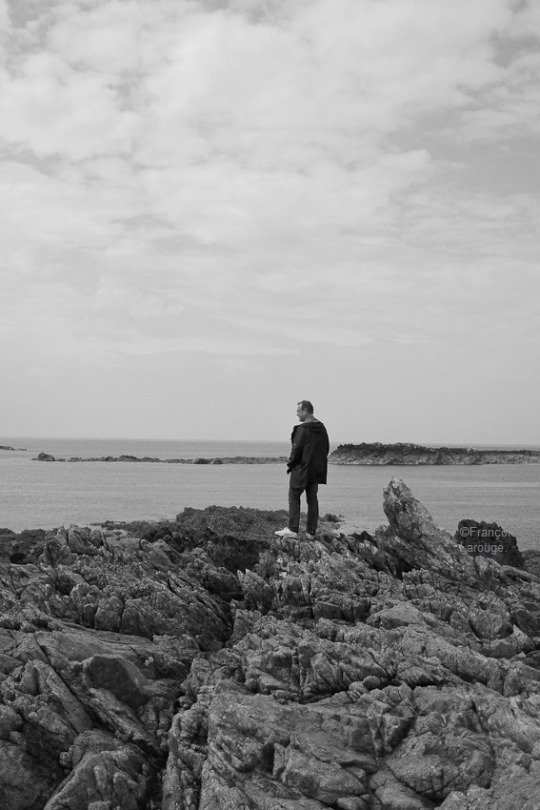
Le Voyageur contemplant la mer©FrançoiseLarouge2023
#photographer on tumblr#bnwphotooftheday#photographie noir et blanc#voyageur#mer#composition#noir c'est noir#photographie humaniste#photographe humaniste#bnw_shots#bnw_drama#bnw#bnw captures#nature#manche#normandie
23 notes
·
View notes
Text

Générations Tsiganes
©2015 : EBodinPhotography Site : https://ebodinphotography.com/ (pensez à laisser un message dans le livre d'or)
#gitan#gipsy#grandmere#tsigane#tzigane#sieste#peuple#voyageur#nb#bw#mariage#photo#photo06#photonice#photonice06#photopaca#ebodin#ericbodin#ebodinphotography#photographe
3 notes
·
View notes
Text
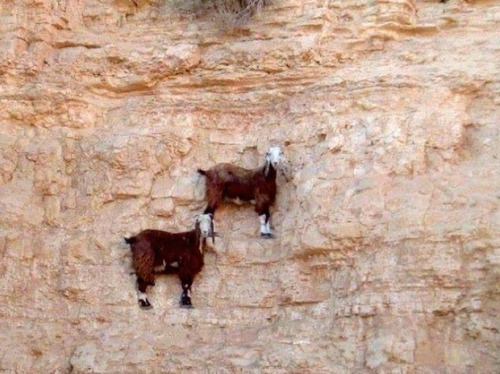
How on earth did these goats get there?
*****
In reality the goats are lying on their sides on rocky ground, looking up at a crane-mounted camera. The photograph was taken some years ago, part of a series reconstructing Central European folk customs and traditions which have fallen from favour or are now prohibited.
This old-fashioned rural blood-sport was originally practiced in parts of Anatolia, Turkey, where the game was called keçi fırlatmak, and also in the Carpathian Alps of Romania, possibly imported during the Ottoman conquest. The name there was aruncarea caprei.
*****
The goats would have been coated in a strong adhesive traditionally distilled from pine resin.(represented pictorially here by darker patches of dye on the flanks) and were then thrown upwards towards a cliff or rock-face with makeshift catapults, often a primitive form of counterweight trebuchet assembled from wooden beams and weighted with rocks.
The game ended when the glue dried and lost adhesion, and the goats fell to their deaths. They were then cooked and eaten, their meat being valued like that of Spanish fighting bulls.
The meat of the last goat to fall (başarılı keçi or cea mai durabilă capră) was prized as a special delicacy and selected cuts from the legs of this particular “winner” goat were often smoked and dried into a kind of jerky.
*****
In his “Grandes Histoires Vraies d'un Voyageur le 1er Avril” (pub. Mensonges & Faussetés, Paris, 1871) French folk-historian, anthropologist and retired cavalry general Gilles-Etienne Gérârd wrote about witnessing a festival near Sighișoara, Transylvania, in 1868.
There he claims to have seen catapults improvised from jeunes arbres, très élastiques et souples - “very springy and flexible young trees” - which were drawn back with ropes and then released.
Bets were placed before the throw, and marks given afterwards, according to what way up the goats adhered and for how long. The reconstruction, with both goats upright, facing outward and still in place, shows what would have been a potential high score.
The practice has been officially banned in both countries since the late 1940s, but supposedly still occurred in more isolated areas up to the end of the 20th century. Wooden beams from which the catapults were constructed could easily be disguised as barn-rafters etc., and of course flexible trees were, and are, just trees.
*****
Gérârd’s book incorrectly calls the goat jerky “pastrami”, to which he gives the meaning "meat of preservation".
While pastrami may be a printing error for the Turkish word bastırma or the Romanian pastramă, both meaning “preserved meat”, at least one reviewer claims that Gérârd misunderstood his guide-translator, who would have been working from rural dialect to formal Romanian to scholarly French.
Since this jerky was considered a good-luck food for shepherds, mountaineers, steeplejacks and others whose work involved a risk of falling, Gérârd's assumption seems a reasonable one.
However, several critical comments on that review have dismissed its conclusion, claiming "no translator could be so clumsy", but in its defence, other comments point out confusion between slang usage in the same language.
One cites American and British English, noting that even before differences in spelling (tire / tyre, kerb / curb etc.) "guns" can mean biceps or firearms, "flat" can mean a deflated wheel or a place to live, "ass" can mean buttocks or donkey and adds, with undisguised relish, some of the more embarrassing examples.
This comment concludes that since the errors "usually make sense in context", Gérârd's misapprehension is entitled to the same respect.
*****
The good-luck aspect of the meat apparently extended to work which involved "falling safely", since its last known use was believed to be in ration packs issued to the 1. Hava İndirme Tugayı (1st Airborne Brigade) of the Turkish Army, immediately before the invasion of Cyprus in July 1974.
Nothing more recent has been officially recorded, because the presence of cameras near military bases or possible - and of course illegal - contests is strongly (sometimes forcefully) discouraged, and the sport’s very existence is increasingly dismissed as an urban or more correctly rural legend.
The official line taken by both Anatolian and Carpathian authorities is that it was only ever a joke played on tourists, similar to the Australian “Drop-bear”, the Scottish “Wild Haggis” and the North American “Jackalope”.
They dismiss the evidence of Gérârd’s personal observation as “a wild fable to encourage sales of his book”, “a city-dweller’s misinterpretation of country practices”, or even “the deliberate deception of a gullible foreigner by humorous peasants”.
And as for those paratroop ration packs, Turkish involvement in Cyprus is still such a delicate subject that the standard response remains “no comment”.
88 notes
·
View notes
Text






Photos by bluesgrass on DeviantArt and Voyageurs Wolf Project
As stated in my previous update post, I've been struggling to really find myself in a coat coloration, as it's difficult to find what I see in my mind's eye in photographs. I flip-flop between describing myself as a gray wolf with a red wolf's coat while understanding I will never find that and editing existing tawny-colored wolves to look red. At the end of the day, I think I find the most luck by grasping onto a select few individuals, and I thought of this as a good place to show off some of those individuals.
The first photos are of a wolf in a facility. There are other images from this photographer of this very wolf that are extremely common and seen pretty regularly in our own community with deep red fur all over and an almost black mask and back. I've always seen this wolf as one alike myself in appearance, but the more common photos of it always felt so edited, like if you saw it in real life, you wouldn't recognize it. The ones I've chosen to show here feel far more like me. I see myself more with a dark back and mask, but with a lot of prominent red around the ears and muzzle. Unlike the shown photos though, I see my mane, sides, and tail also carrying this red, rather than the tawny that this individual has.
The next set of photos show a wolf in the wild. I don't remember if these are all the same individual or not, but it's safe to say I love this group for the photos they get. They seem to always have this warmth to the fur of their subjects that make me feel like I'm looking at myself. Again, there's often a dark back and mask, but these also have the red going from muzzle to tail, which is why I feel so connected to it.


Images from Alibaba and eBay
I can't deny that my self-image is likely so rare because it is a product of photo editing or lighting and camera differences, but I like to think it's entirely possible. Boltz from the Wolf Conservation Center, for example, I felt was pretty similar to my own coat. Though, the main place that I've found a good general vision of myself is in plushes of red wolves. The images I've included are of plushes that I have my own of at home, and they are both easily some of my favorites of all time. Their very saturated and warm colors throughout their bodies, unbroken by gray or tan, feels very much like me, and while I don't think I actually carry reds and gingers like the plushes, likely more of an auburn mixed in with brown and black accents across the complex coat a wolf would have, they are a great starting point for me, and I find myself thinking of them when I try to imagine my pelt when creating art of myself or describing myself to others.
Long post short, I say all of this to get my thoughts out about how my coat has consumed my mind for days, weeks, months, even years. It's a weird, complex thing that mixes in with my own human body, the mixing of my identity as multiple kinds of wolves, gray and red, my past experiences with red foxes, and my youth full of wolf OCs and a community with a lot more members using "unrealistic" images to show others how they feel inside. I don't know if I'll ever have a concrete self-image, but I think that's okay. I don't think I ever need to know, as long as I'm content in myself. Simply saying I'm a "red-furred wolf" is enough the vast majority of the time, and that's good enough for me.
#therian#therianthropy#alterhuman#alterhumanity#wolf therian#wolf theriotype#wolfkin#red wolf therian#red wolf theriotype#red wolfkin
8 notes
·
View notes
Text

Août 1997.
Mariage. Vous avez dit mariage ?
Vacances en Sicile avec Nisa. On se balade avec comme guide le routard et une carte routière. Le pays est magnifique. Pas de notes, ce qui est malgré tout une erreur pour le voyageur que j'étais, même en vacances. Il y a des ruines le long de la route, sur le bord de la mer, cela devrait être facile de retrouver le nom de l'endroit. Mais est-ce vraiment important. Le spectacle est autre, c'est un mariage qui attire notre attention. Le jeune couple est accompagné de deux photographes et un cameraman, c'est enregistré sur une deuxième photo que je passerai peut-être un autre jour. Nous avons peut-être échangé avec eux, je ne me souviens pas ; Nisa parle italien. Elle a vécu dans sa jeunesse un certain temps dans ce merveilleux pays, mais beaucoup plus vers le nord.
Ce journal accueillera pendant quelques jours des photos de mariages glanées au fil du temps et des routes.
3 notes
·
View notes
Text

Ouiiii Merci Ninie ! Le dernier Amélie Nothomb ! « L’impossible retour », c’est l’impossible retour d’Amélie au Japon, qui est son pays fondamental, celui par lequel elle se définit.
Et pourtant, grâce ou à cause d’une amie très chère, elle se voit obligée d’y retourner en mai 2023. Elle y est née et y a passé les cinq premières années de sa vie avant de déménager en Chine.
Ce roman sur son périple nippon, c’est un livre nécessaire, elle s’y dévoile comme jamais. Elle y expose son amour pour le Japon et en hologramme celui pour son père aujourd’hui décédé. Très psychanalytique, c’est un mélange d’hypermnésie et d’amnésie. C’est un livre aussi très sensuel où les sentiments passent par les couleurs, la nourriture, le théâtre de No (la chanson)… Et puis la fantaisie quand même ! Son amie Pep Beni, photographe fantasque, est pleine de névroses, elle est aussi très occidentale dans ce pays très discipliné et cela occasionne des situations assez cocasses.
Bref, j’ai aimé comme j’aime cette femme : Amélie Nothomb.
« Il me faut vaincre, pour partir, un amour aussi puissant que l'inertie.
Rappel : l'inertie est la résistance d'un objet à une force exerçant sur lui un mouvement. Le dictionnaire y voit une propriété. Je me permets de trouver cela inexact. Une propriété, c'est presque une épithète homérique. L'inertie, c'est beaucoup plus grave.
Partir m'apparaît toujours comme une violence. Et pourtant, il s'agit de départs tellement plus bénins que ceux de ma jeunesse, puisque je suis assurée de revenir. »
« Quand Paul Bowles déclarait que le voyageur digne de ce nom était celui qui n'était pas sûr de revenir, il ne parlait évidemment pas pour mon cas pathologique, puisque, au lieu de vivre cette incertitude avec une noblesse métaphysique, je l'appréhende de la pire manière. Les veilles de départ, je ne dors pas : je suis trop accaparée par mes adieux à mon lit, à mon placard, à mon quotidien. »
« J'avais cinq ans et je savais que j’allais quitter le Japon et j'en avais d'avance le cœur déchiré. Et mon père également. Nous avions lui et moi inventé la nostalgie préventive : idée romantiquement funeste, vaccin inspirant, se contentant d'agrandir dans l'âme la région dévolue à la nostalgie rétrospective. »
« À présent, je ne suis plus harcelée par des supérieurs hiérarchiques mais par des lapins. L'une de ces adorables petites bêtes vient déposer des crottes sur mon pied.
- Il t'aime ! s'extasie Pep.
L'amour a bien des mystères. J'ai envie de secouer mon pied, mais je devine que j'offenserais ce nouveau prétendant et que Pep ne me le pardonnerait pas. »
#photographie#photography#lecture#bookaddict#book#citation#booklover#amélie nothomb#Japon#albin michel
2 notes
·
View notes
Text
10 National Parks To Avoid The Summer Crowds
From rugged hiking trails to pristine beaches, upgrade your summer at these under-the-radar wilderness areas.
— By Elizabeth Kwak-Hefferan | June 2, 2023

Two spelunkers explore Lechuguilla Cave—currently reserved for scientific research—in Carlsbad Caverns National Park, home to some of the deepest, largest, and most ornate caverns in the U.S. Photograph By Robbie Shone, National Geographic Image Collection
The most popular national parks in the U.S. such as Yellowstone and the Grand Canyon attracted record crowds last summer. For some, it might be worth fighting traffic or walking packed trails to see the towering granite monoliths in Yosemite or fireflies in Great Smoky Mountains. But, there are 63 national parks across the country, many with far fewer visitors—and just as many hikes with epic views, wildlife-spotting opportunities, and kid-friendly excursions.
Here are 10 of the country’s least trafficked parks, plus what to see and do in them.
Best Water Excursions: Channel Islands National Park, California
Hikers and kayakers find ample ways to explore this constellation of five wild islands off the coast of Santa Barbara. Beginner-friendly paddling trips, like the one from Scorpion Anchorage on Santa Cruz Island, let visitors take in abundant sea caves, kelp forests, and wildlife such as gray whales, dolphins, and sea lions. Strong currents and shifting weather make going with a guide a smart move.
Remote islands like Santa Rosa have hiking trails through rugged mountains with glimpses of wildlife, including tiny, endemic island foxes, at dawn and dusk. Spend the night at Santa Cruz Island’s only lodging option, Scorpion Canyon Campground, a half-mile hike from the beach.

Composed of five tectonically formed islands and surrounded by an extensive marine sanctuary, Channel Islands National Park offers ���dramatic sea views, epic wildlife watching, and scenic hikes. Photograph By Robert Schwemmer/Alamy Stock Photo
Voyageurs National Park, Minnesota
More than a third of this Northwoods network of boreal forests and rocky islands is covered by water—four huge lakes plus 26 smaller ones. New environmental protections make now an ideal time to experience these waterways via a tour boat, canoe, or kayak. Easy-access shoreline campsites line the park’s major lakes, but the wildest, quietest destinations sit deep in the interior of the Kabetogama Peninsula. Reserve a backcountry campsite along the Chain of Lakes or on the central peninsula’s waters, where your only companions for a spectacular aurora borealis show will be the loons and moose.
Best Wildlife Viewing: Kenai Fjords National Park, Alaska
This coast-meets-mountains reserve takes wildlife watching to the next level. Use the park’s only maintained long trail to the outlook over Harding Icefield for breathtaking panoramic views of this expansive, icy landscape. Along the way, keep an eye out for grizzlies, black bears, wolverines, lynx, wolves, and mountain goats. From a kayak or tour boat, look out for orcas, humpback whales, and dolphins among the waves and Steller sea lions and harbor seals on the beaches
Carlsbad Caverns National Park, New Mexico
Brazilian free-tailed bats are a star attraction at this Chihuahuan Desert park. Each year, these flying critters make their way back from their winter grounds in Mexico to roost in the park’s intricate network of limestone caves. August and September bring the best bat watching when the year’s babies take to the skies with their parents. Around sunset, the bats spiral out of the cavern’s Natural Entrance by the hundreds of thousands to eat insects.
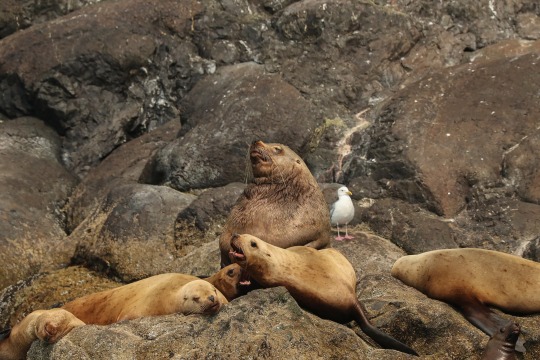

Top: The glacial landscapes and coastal waters of Alaska’s Kenai Fjords National Park provide ideal conditions for viewing wildlife, like these Steller sea lions pictured. Photograph By Cagan Sekercioglu. Bottom: Thousands of bats spew out of a cave in Carlsbad Caverns in search of food. Photograph By Michael Nichols — National Geographic Image Collection
Best Hiking Trails: North Cascades National Park, Washington
Known as the “American Alps,” this park holds more than 400 miles of trails that take hikers and horseback riders to wildflower meadows, old-growth forests, glacier viewpoints, and remote lakes. One standout is the Desolation Peak Trail, which leads to a mountaintop lookout cabin where Jack Kerouac spent a summer. North Cascades remains well off the radar: Just over 30,000 people visited last year, a mere 2 percent of the traffic of its southern neighbor, Mount Rainier. The terrain is so remote and wild, the park is considering restoring grizzly bear populations here.
Mesa Verde National Park, Colorado
Explore the sunset-colored canyons that ancestral Pueblo people called home in Mesa Verde. Here, skillfully designed cliff dwellings, some with up to 150 rooms and large enough to house one hundred people, remain tucked into protected stone alcoves, just as they’ve been for 800 years. In summer, rangers lead hiking tours inside some of them, including Cliff Palace, the largest such village in North America, and Balcony House, which involves climbing up cliffside ladders and crawling through rock tunnels. After dark, look up. Mesa Verde’s skies are well-protected from light pollution, earning it International Dark Sky Park status in 2021.

Tourists visit the ruins of Cliff Palace in Mesa Verde National Park., Colorado.Photograph By Phil Schermeister, National Geographic Image Collection
Best Cultural Experiences: Dry Tortugas National Park, Florida
Accessible only by boat or seaplane, this park offers pristine beaches, exceptional snorkeling, and the chance to explore the historic Fort Jefferson. Located on Garden Key, the second largest of the park’s seven islands (70 miles from Key West), the military stronghold was the largest masonry fort in the Western Hemisphere during the mid-1800s. During the Civil War, it became one of the nation’s largest prisons.
Visitors who brave the two-plus-hour trip by boat or 40-minute ride by plane to get here can tour the grounds where Union prisoners (like the doctor who set John Wilkes Booth’s broken leg) were imprisoned during the Civil War. After strolling the grounds, explore Dry Tortugas’s other major attraction: superb snorkeling among coral reefs where you might see octopi, nurse sharks, reef squid, and barracudas.
Haleakalā National Park, Maui, Hawaii
More than 30 miles of trails wind over ancient lava flows and through endemic silversword patches before plunging into the summit crater of Haleakalā. Native Hawaiians consider the summit a sacred site, where they held religious ceremonies, studied the stars, and quarried basalt for centuries. On the other side of the park, visitors can still see their village ruins and fishing shrines at tropical Kipahula, an 800-year-old coastal settlement that’s now better known for its crashing waterfalls and the idyllic Seven Sacred Pools of ‘Ohe’o Gulch.
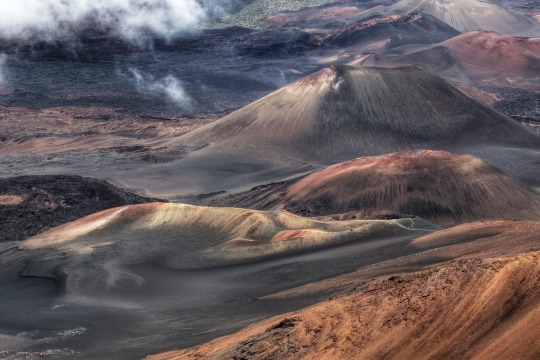
The famed Haleakalā Crater is a vast depression—but it's actually not a volcanic crater. It was formed as erosion ate away a ridgeline, joining two valleys in Haleakalā National Park. Photograph By Pete Ryan, National Geographic Image Collection


Top: To avoid crowds, visit Haleakalā summit after 3 p.m.; its sunsets can be as spectacular as its famous sunrises. Bottom: Erected in 1958, the Haleakalā Observatory is Hawaii’s first astronomical research planetarium. — Photographs By Babak Tafreshi, National Geographic Image Collection
Best For Family: Indiana Dunes National Park, Indiana
Kids will find more than just a day at the beach in this welcome pocket of nature amidst the nearby bustle of Chicago, a 45-minute drive away. An impressively diverse number of ecosystems in this compact park let families explore wetlands, oak savannas, pine forests, prairies, and 15 miles of sandy shoreline in a day.
There are also opportunities for kayaking the coast of Lake Michigan or canoeing the Little Calumet River (the park was upgraded from national lakeshore status in 2019). The in-progress Indigenous Cultural Trail features murals and interpretive signs that teach about the Pokagon Band of Potawatomi and the Miami Tribe of Oklahoma, two of the area’s original peoples.


Top: Mammoth Cave—Kentucky’s only national park—contains more than 400 miles of caves, making it the longest cave system in the world. Photograph By Phil Schermeister, National Geographic Image Collection Bottom: Park visitors stand up paddle board along the Grand Calumet River on the outskirts of Lake Michigan in Indiana Dunes National Park. Photograph By Keith Ladzinski, National Geographic Image Collection
Mammoth Cave National Park, Kentucky
Escape the summer heat by exploring a labyrinth of underground caverns that maintain a refreshing temperature of 54°F year-round. To see the caves, you’ll have to take a ranger-guided tour. These vary in difficulty, with options for families with young kids to enjoy the stunning stalagmites, stalactites, and tunnels. Or for the older kids, try the longer, more challenging tours by lantern light.
During the guided tours, park rangers point out remnants of early inhabitants’ mining activity dating back to 1200 B.C. and tell the stories of enslaved Black cave guides from the 1830s and the “Cave Wars” between rival tourism developers in the early 1900s.
4 notes
·
View notes
Text

« Quant à la façon dont je suis arrivé ici, elle a été accidentée et rafraîchie de temps en temps par la saison. Sur la ligne droite des Ardennes en Suisse, voulant rejoindre, de Remiremont, la correspondance allemande à Wesserling, il m'a fallu passer les Vosges ; d'abord en diligence, puis à pied, aucune diligence ne pouvant plus circuler dans cinquante centimètres de neige en moyenne et par une tourmente signalée. »
(Lettre d’Arthur Rimbaud à sa famille, Gênes, le 17 novembre 1878)
_______________________________________________________________________
À quel endroit Arthur Rimbaud a-t-il franchi les Vosges ? Combien de kilomètres a-t-il parcouru « par une tourmente signalée » ?
_______________________________________________________________________
La ligne ferrovière Mulhouse-Thann est ouverte en 1839. En 1863, la prolongation de Thann à Wesserling rapproche les voyageurs du col de Bussang, qui n’est plus qu’à 9 km. Ces deux communes situées sur le flanc alsacien des Vosges, deviennent allemandes après la guerre de 1870. Le col de Bussang devient un poste frontière et le restera jusqu'en 1918.
Il se trouve dans la partie sud du tracé de la nouvelle frontière franco-allemande, issue du traité de paix de Francfort (10 mai 1871). Cette ligne plantée de 4056 bornes, valide la cession du Haut-Rhin, du Bas-Rhin et de la Moselle à l’empire allemand. Elle descend le long du bassin lorrain, rejoint la crête des Vosges, qu'elle suit du nord au sud, traverse le Territoire de Belfort pour atteindre la Suisse. Le col de Bussang se situe à environ 50 km à vol d’oiseau de la Suisse, au niveau de la borne frontière n°3100.
vimeo
Dans le sens Vosges-Alsace, Rimbaud monte dans le train à Épinal pour en descendre à Remiremont, le terminus, à 35 kilomètres du col. La diligence le conduit à Bussang, en longeant la Moselle sur 31 km. C’est la dernière commune française avant la montée vers le col où cette rivière prend sa source. C’est donc là que Rimbaud entame très certainement son périple « dans 50 cm de neige en moyenne et par une tourmente signalée. »
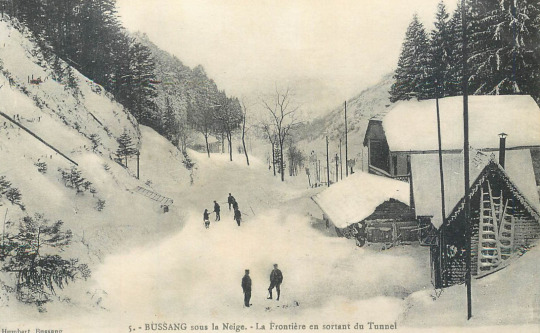
Après 4 km de marche, il atteint la douane française, à l’entrée ouest du tunnel construit sous le col de Bussang. Sur la carte postale, le photographe est perché à son sommet. Les douaniers français sont au premier plan, leur guérite en rondins à droite. À la sortie du tunnel, du côté alsacien, Rimbaud passe le poste frontière allemand et montre ses papiers. Derrière les gendarmes à casque à pointe, on aperçoit un poteau frontière allemand que Rimbaud n'a pas pu voir, ce modèle datant de 1889. Celui qu’il a pu voir est moins spectaculaire.
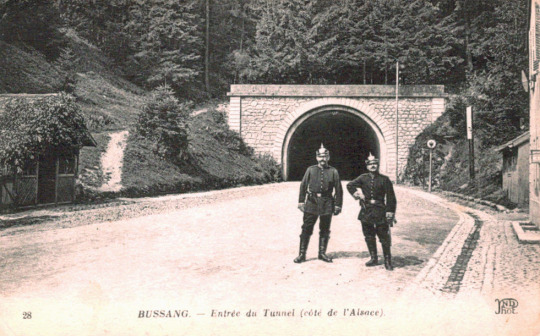
Rimbaud entre dans une Alsace allemande. La guerre de 1870 a joué un rôle essentiel dans son parcours de poète, peut-être aussi dans sa décision de partir loin de son pays. Le poète qui a fréquenté la Commune, qui a écrit l’un des plus beaux poèmes de la langue française en hommage à un soldat mort en 1870, est le bref témoin d’une déchirure territoriale qui a coûté la vie à 200 000 hommes. En traversant les provinces perdues, il foule une terre étrangère, une utopie dérisoire, un lieu qui n’existe pas sinon dans le cerveau de l’empereur Guillaume Ier, du chancelier Bismarck et du général Moltke.
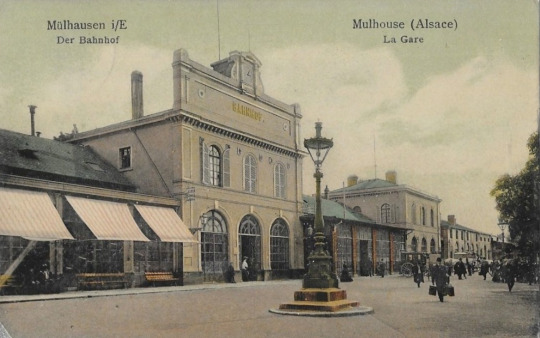
Encore 9 km de marche et Rimbaud atteint la « correspondance allemande à Wesserling ». Il aura donc marché 13 km. Le train quitte la vallée de Thann, atteint bientôt Mülhausen (Mulhouse). Il fait quelques pas dans cette ancienne république protestante longtemps rattachée à la Suisse, aperçoit le Klapperstein, figure grimaçante que les condamnés pour médisance devaient porter autour du cou. Il se réchauffe au café Moll, où il écoute parler un dialecte étrange. Par la vitrine, il contemple le triangle rare d'une jolie place des années 1820, encadrée d'arcades qui encerclent un jardin. Puis il monte dans le train pour Bâle. On le retrouvera bientôt à Chypre, puis en Abyssinie.
3 notes
·
View notes
Text
La photographie et le voyage intimement liés
Toujours dans la continuité de mon blog intitulé photographe voyageur, j’aimerais vous raconter comment le voyage et la photographie sont intimement liés depuis le début de la photographie. En effet, depuis que la photographie existe, les deux sont presque inséparables.Mais même avant cela, avec la peinture, l’être humain a toujours eu ce besoin d’immortaliser les paysages, les gens et les…
#Conseils pour photographes#Histoire de la photographie#Immortaliser ses voyages#Photo#Photographe voyageur#photographie#Photographie d’exploration#Photographie de tous les jours#Pionniers#Souvenirs de voyage#Voyage
0 notes
Text

A beaver grazing in shallow water.
© Voyageurs Wolf Project
48 notes
·
View notes
Text
La Baie de la Concha

La Baie de la Concha, à Saint-Sébastien, est l’un des joyaux les plus emblématiques de la côte cantabrique. Sa forme semi-circulaire caractéristique, encadrée par les monts Urgull et Igueldo, et la présence de l’île Santa Clara en son centre, en font un paysage d’une beauté unique qui a captivé les habitants et les visiteurs au fil du temps. Ce lieu combine histoire, nature et culture dans une expérience inoubliable qui transcende le temps. Les visiteurs ne peuvent s’empêcher de remarquer l’harmonie entre la nature et l’urbanisme, résultat d’un aménagement respectueux du paysage original. Cette combinaison unique attire les artistes, peintres, et photographes qui cherchent à capturer la magie de cet endroit.

La baie n’est pas seulement un espace naturel, mais aussi un symbole de l’identité de Saint-Sébastien, reconnu internationalement. Son impact va au-delà du tourisme, servant également de refuge à la biodiversité marine et de lieu de rencontre pour des générations d’habitants. La faune aquatique y trouve un habitat protégé, tandis que les plages accueillent les familles, les sportifs et les flâneurs. En plus de sa splendeur naturelle, la Baie de la Concha joue un rôle dans le développement économique de la région, attirant des conférences internationales, des festivals et des événements culturels qui renforcent son importance comme icône mondiale. Des initiatives communautaires, comme des nettoyages volontaires ou des programmes éducatifs sur l’environnement, soulignent l’engagement local envers la préservation de ce joyau naturel.
Histoire et Origine de la Baie
Le nom "La Concha" provient de sa forme rappelant une coquille marine, une particularité qui a fasciné les habitants et les visiteurs depuis des siècles. Cette baie a été décrite dans des textes anciens comme un lieu magique lié à la mer, utilisé par les pêcheurs comme point de référence pour leurs activités quotidiennes. Au fil du temps, la baie a évolué pour devenir bien plus qu’un simple espace naturel. Durant la Belle Époque, la baie s’est transformée en une destination privilégiée pour l’aristocratie européenne. Ce changement a marqué un tournant majeur dans l’histoire de Saint-Sébastien, attirant les élites sociales, culturelles et politiques de l’époque. C’est à cette période que les fameux "bains de mer" ont gagné en popularité, recommandés par les médecins pour leurs bienfaits thérapeutiques. Ces pratiques, qui incluaient des activités nautiques et des cures à base d’eau de mer, ont été rapidement adoptées par la royauté, notamment par la reine Isabelle II. Elle a joué un rôle central dans la transformation de la baie en un centre touristique de prestige. La présence royale a inspiré la création d’infrastructures luxueuses, telles que des hôtels somptueux et des casinos, notamment le célèbre Hôtel de Londres y de Inglaterra. Cet hôtel, qui continue d’��blouir les visiteurs aujourd’hui, est le témoin vivant de cette époque florissante. Durant la Guerre Civile Espagnole, la baie a été le théâtre d’événements marquants qui ont laissé une empreinte indélébile sur la ville. En dépit des périodes difficiles, elle est restée un symbole de résilience. Pendant la reconstruction, après les conflits, la baie a joué un rôle clé dans le rétablissement de Saint-Sébastien en tant que destination internationale. Les habitants, tout comme les visiteurs, ont trouvé dans ce lieu une source d’espoir et de renouveau. Chaque étape de son histoire, des jours de gloire aux périodes de résilience, fait de la baie un véritable livre ouvert sur l’évolution de la ville. Aujourd’hui, La Concha continue de symboliser l’harmonie entre l’homme et la nature, offrant à chaque visiteur une expérience qui transcende les simples loisirs. Sa beauté naturelle, associée à son riche passé, inspire artistes, historiens et voyageurs du monde entier. Des expositions, des festivals artistiques et des promenades guidées dans ses environs rendent hommage à son importance historique et culturelle.
Les Plages de la Baie
La baie abrite trois plages qui sont de véritables trésors : - Plage de La Concha : Avec son sable doré et ses eaux calmes, cette plage est idéale pour les familles et les amateurs de détente. Elle s’étend sur environ 1 350 mètres, offrant un espace parfait pour les promenades le long du rivage ou pour se détendre sous le soleil. Sa position centrale permet un accès facile depuis tous les quartiers de la ville, en faisant l’une des plages les plus fréquentées du nord de l’Espagne. Au lever et au coucher du soleil, La Concha se pare de reflets dorés, faisant le bonheur des photographes et des rêveurs. Son cadre idyllique inspire également les sportifs qui trouvent dans ses eaux calmes un lieu parfait pour des activités comme la natation ou le paddle. - Plage d’Ondarreta : Plus tranquille et familiale, cette plage située à l’ouest de La Concha est parfaite pour les sports comme le volley-ball ou le surf. Entourée de jardins et d’œuvres d’art, comme le célèbre « Peigne du Vent » d’Eduardo Chillida, Ondarreta offre une connexion unique entre nature et créativité. La proximité des jardins de Miramar ajoute une ambiance paisible à cet espace, idéal pour des pique-niques ou des journées en famille. Les amateurs de sensations fortes peuvent également pratiquer le surf dans ses vagues modérées. - Plage de l’île Santa Clara : Ce petit éden de sable apparaît à marée basse et offre un refuge unique pour ceux en quête de tranquillité. Accessible en bateau ou à la nage, sa localisation au cœur de la baie propose des vues spectaculaires et une expérience intime loin de l’agitation. En été, un petit bar sur l’île ajoute une touche de convivialité pour les visiteurs. L’œuvre « Hondalea » de Cristina Iglesias, située dans l’ancienne maison du gardien de phare, enrichit cette expérience en mariant art et nature. La plage devient un lieu de rendez-vous estival pour les familles et les groupes d’amis.
L’île Santa Clara : Le Trésor de la Baie
L’île Santa Clara est un joyau naturel qui confère à la Baie de la Concha son caractère unique. Ce lieu abrite des sentiers permettant d’explorer sa végétation locale et d’atteindre des points de vue offrant un panorama exceptionnel sur la ville et la mer. Outre son phare pittoresque, l’île possède une histoire riche, ayant servi de refuge pour les pêcheurs et de lieu de repos pour les navigateurs. En été, sa plage devient un espace convivial prisé par les habitants et les touristes. L’île offre également un habitat protégé à une faune variée, notamment des oiseaux marins. Pour les plus aventuriers, la nage jusqu’à l’île reste une expérience inoubliable. Des visites guidées permettent d’en apprendre davantage sur son histoire et sa biodiversité unique.
Le Promenade de La Concha
Le Promenade de La Concha, avec sa balustrade blanche iconique, est l’un des lieux les plus photographiés de Saint-Sébastien. Ce chemin longe la baie et relie des points d’intérêt tels que le Palais de Miramar, autrefois résidence royale et aujourd’hui centre culturel. Idéal pour des balades ou des activités sportives en plein air, cet espace est également agrémenté d’éclairages créant une ambiance romantique la nuit. Les bancs stratégiquement disposés permettent de contempler calmement ce paysage unique. De nombreux visiteurs profitent également de ce lieu pour admirer les feux d’artifice qui illuminent la baie lors des grandes célébrations annuelles.
Activités et Événements dans la Baie
- Régates de Trainières : Ces compétitions de rame, organisées chaque septembre, rassemblent des milliers de spectateurs et incarnent l’esprit maritime basque. - La Semaine Grande : En août, cette célébration anime la baie avec concerts, activités et feux d’artifice spectaculaires. Elle attire des visiteurs locaux et internationaux qui se mêlent aux habitants dans une ambiance festive inoubliable. - Sports nautiques : Le paddle, le kayak et la voile sont des activités populaires grâce aux eaux tranquilles de la baie. Des cours sont disponibles pour les débutants et les experts. Ces activités permettent de profiter pleinement du cadre naturel tout en découvrant les environs de manière active et ludique.
Gastronomie et Vues Exceptionnelles
Saint-Sébastien est renommée pour sa gastronomie, et les environs de la baie regorgent de restaurants proposant des pintxos traditionnels et de la haute cuisine. Déguster des fruits de mer frais tout en contemplant les vagues est une expérience à ne pas manquer. Les marchés locaux, comme celui de San Martín, offrent aussi des produits frais pour un pique-nique dans les jardins de la baie. Certains restaurants offrent des dégustations gastronomiques accompagnées de cours de cuisine, permettant aux visiteurs de s’immerger dans la culture culinaire locale.
Conservation et Durabilité
La préservation de la Baie de la Concha est essentielle. Des programmes de nettoyage réguliers et la promotion d’un tourisme durable garantissent que cet écosystème unique soit protégé pour les générations futures. La réintroduction d’espèces marines locales contribue à l’équilibre écologique et enrichit la biodiversité. De plus, des initiatives sensibilisent les visiteurs à l’importance de préserver cette région emblématique. Des efforts communs entre les autorités locales, les habitants et les touristes garantissent un avenir durable pour cette baie exceptionnelle.
Légendes et Curiosités
Des mythes entourent la baie, comme celui de l’existence de grottes cachées sur l’île Santa Clara. Par ailleurs, des rumeurs sur un galion naufragé près de l’île excitent la curiosité des plongeurs et des archéologues. Ces histoires enrichissent l’attrait culturel et mystique de la baie. Des visites thématiques organisées dans la ville permettent aux curieux de plonger dans ces récits fascinants tout en découvrant les secrets bien gardés de cet endroit magique. En somme, la Baie de la Concha est un lieu incontournable de Saint-Sébastien, offrant une harmonieuse combinaison de nature, d’histoire et de culture qui fascine tous ses visiteurs. https://www.sansebastianturismoa.eus Read the full article
0 notes
Text
Bhutan: Unveil the Land of the Thunder Dragon with Langur Eco Travels (For French Travelers)
birding tour, Eco travels, cultural tour , best travel agency, Bhutan tour
For the adventurous spirit of French travelers, Bhutan beckons. Nestled amidst the majestic Himalayas, this mystical kingdom transcends the ordinary. Imagine a land where breathtaking landscapes meet a rich cultural tapestry, all woven together by a philosophy centered around Gross National Happiness. Langur Eco Travels, your trusted partner in Bhutanese exploration, invites you to discover the magic of this hidden gem on a tailor-made tour designed specifically for French travelers.
Un voyage à travers le temps : Dévoilement de la tapisserie culturelle du Bhoutan
L'héritage culturel du Bhoutan est un témoignage vivant de son histoire et de ses traditions uniques. Plongez dans cette tapisserie avec Langur Eco Travels et découvrez l'essence du Bhoutan à travers :
Dzongs : Merveilles architecturales: Admirez la splendeur architecturale des Dzongs emblématiques du Bhoutan (monastères-forteresses). Explorez le Punakha Dzong, la résidence d'hiver du Je Khenpo (abbé en chef), ou émerveillez-vous devant l'imposant Paro Dzong, un site classé au patrimoine mondial de l'UNESCO. Imaginez les chuchotements de l'histoire à l'intérieur de ces murs anciens, qui servaient autrefois de centres religieux et militaires.
Monastères : Chuchotements de spiritualité: Trouvez la sérénité au milieu de monastères paisibles perchés sur les flancs des montagnes. Faites une randonnée jusqu'au monastère de Taktsang (Nid du Tigre), un monastère à couper le souffle accroché à une falaise, ou explorez les œuvres d'art complexes et les chants des moines de Jambey Lakhang, l'un des plus anciens monastères du Bhoutan. Respirez l'air frais de la montagne et imprégnez-vous de la tranquillité qui imprègne ces lieux sacrés.
Festivals : Une célébration de la vie: Plongez dans les couleurs vibrantes et l'énergie joyeuse des nombreux festivals du Bhoutan. Assistez aux danses masquées et aux costumes traditionnels du festival Paro Tshechu, ou découvrez les compétitions de tir à l'arc et les spectacles culturels du festival Thimphu Tsechu. Ces célébrations animées offrent une fenêtre sur la culture et les traditions bhoutanaises, vous permettant de vous connecter à l'esprit local.
Nuits chez l'habitant : Aventurez-vous au-delà des principaux centres touristiques et découvrez la chaleur de l'hospitalité bhoutanaise dans une maison d'hôtes traditionnelle d'un village. Rencontrez les habitants, découvrez leur mode de vie unique et assistez à des traditions ancestrales pratiquées depuis des générations. Savourez un repas cuisiné à la maison préparé avec des ingrédients locaux frais et acquérez une compréhension plus profonde de la culture bhoutanaise.
Au-delà de la tapisserie culturelle : Exploration des merveilles naturelles du Bhoutan
Les paysages à couper le souffle du Bhoutan offrent quelque chose pour tous les amoureux de la nature. Langur Eco Travels propose des itinéraires qui mettent en valeur la beauté naturelle du royaume, répondant à l'esprit d'aventure des voyageurs français :
Trekking dans l'Himalaya: Embarquez pour un trek passionnant à travers l'Himalaya, entouré de sommets enneigés et de vallées luxuriantes. Optez pour le trek difficile du Jomolhari pour des vues imprenables sur les montagnes, ou choisissez le trek plus facile du col de Dochula pour des panoramas à couper le souffle sur les forêts de rhododendrons. Relevez le défi de ces randonnées enrichissantes et respirez l'air frais de la montagne.
Paradis pour les photographes amateurs de nature: Les paysages variés du Bhoutan, des forêts subtropicales aux prairies alpines, constituent le rêve de tout photographe. Capturez les couleurs vibrantes des drapeaux de prière flottant au vent, les majestueux sommets enneigés ou les cabrioles ludiques du takin, l'animal national du Bhoutan. Avec sa flore et sa faune uniques, le Bhoutan est un paradis pour les photographes cherchant à capturer l'essence de ce royaume caché.
Randonnée à vélo ou VTT : Explorez le terrain diversifié du Bhoutan lors d'une aventure en VTT ou à vélo. Traversez des vallées pittoresques, passez devant des villages charmants et découvrez la beauté de l'Himalaya sous un angle unique. Choisissez votre rythme, que vous recherchiez une ascension difficile ou une balade tranquille.
See more
birding tour, Eco travels, cultural tour , best travel agency, Bhutan tour
Bhutan birding tour , Eco travels, Bhutan tour packages , long tour packages, wild
life sanctuaries Bhutan tour packages
0 notes
Text

Pygargue à Queue Blanche
Le plus g rand rapace d'Europe ©2018 : EBodinPhotography Site : https://ebodinphotography.com/ (pensez à laisser un message dans le livre d'or)
#gitan#gipsy#grandmere#tsigane#tzigane#sieste#peuple#voyageur#nb#bw#mariage#photo#photo06#photonice#photonice06#photopaca#ebodin#ericbodin#ebodinphotography#photographe
#voyageur#photo#photo06#photonice#photonice06#photopaca#ebodin#ericbodin#ebodinphotography#photographe#pygargue#Aigle#Aigledemer#norvege#capnord#northcap#norway#rapace#oiseau#nature
1 note
·
View note